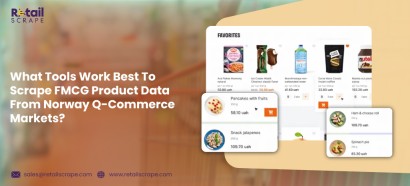


Discover top strategies and tools to scrape FMCG product data from Norway’s quick commerce platforms for real-time, actionable market insights.
In the rapidly evolving retail environment, Norway’s quick commerce (Q-commerce) sector has emerged as a transformative force in how consumers access and purchase fast-moving consumer goods (FMCG). With the popularity of on-demand delivery platforms such as Oda, Kolonial, and Foodora Market, there’s a growing demand for real-time product, pricing, and inventory data. For businesses, marketers, and researchers, the ability to scrape FMCG product data from these platforms can provide a significant competitive edge.
Whether you’re monitoring pricing trends, analyzing competitor assortments, or forecasting market demand, accurate and scalable data scraping is essential. This blog explores the best tools, techniques, and tips for extracting structured and meaningful data from Norway’s leading Q-commerce platforms.
Norway’s digital retail market is uniquely structured. With high mobile usage, strong logistics infrastructure, and consumer preference for speed and convenience, Q-commerce has gained considerable traction. Platforms like Oda (formerly Kolonial.no) lead the way in grocery delivery, offering a wide range of FMCG items with frequently updated pricing and availability.
Scraping data from these platforms allows businesses to:
Track real-time pricing changes across categories.
Monitor stock availability and delivery patterns.
Benchmark promotional strategies used by competitors.
Understand consumer preferences through category-level analysis.
To scrape FMCG product data effectively from Norway-based platforms, you need robust tools that handle dynamic content, localized interfaces, and anti-bot mechanisms. Here are some popular options:
Python remains a top choice for web scraping due to its versatility and library ecosystem.
Scrapy: Best for large-scale scraping projects with built-in request handling, pipelines, and error handling.
BeautifulSoup: Ideal for parsing HTML/XML in smaller tasks.
When platforms rely heavily on JavaScript rendering (like Foodora Market), browser automation tools such as Selenium or Playwright are essential.
Automates user interactions like clicks and scrolls.
Handles login-based sessions and dynamic content.
Useful for capturing product modals, offers, and variant pricing.
Norwegian platforms may use geo-blocking or bot-detection tools. Using residential or rotating proxies helps maintain scraping consistency while staying under the radar.
Platforms like ScraperAPI, Bright Data, and Octoparse offer cloud-based solutions that eliminate the need to maintain infrastructure and provide GUI-based scraping options.
To ensure effective and ethical scraping, consider these practices:
Some platforms serve different content structures on mobile vs desktop. Scraping both versions ensures data completeness.
Use localization libraries or APIs to standardize product names and convert prices from NOK to your preferred currency for global analysis.
For pricing intelligence, daily or hourly crawls may be essential. For catalog monitoring, weekly data may suffice.
Always respect robots.txt where applicable, and implement proper delays between requests to avoid server bans.
Businesses and analysts can leverage scraped data in multiple ways:
Competitive Pricing: Adjust pricing strategies based on real-time competitor prices.
Inventory Optimization: Track frequently out-of-stock items to improve product planning.
Trend Analysis: Spot seasonal or regional product trends across Q-commerce platforms.
Market Expansion: Identify gaps in product offerings when planning to enter or expand in the Norwegian market.
Scraping FMCG product data from Norway’s quick commerce platforms can unlock actionable insights for pricing, marketing, and inventory strategies. With the right tools and a compliance-first approach, businesses can stay agile in an increasingly digital and competitive retail space.
Whether you’re a startup exploring the Norwegian grocery space or an enterprise optimizing your Q-commerce strategy, real-time data scraping is an indispensable tool in your analytics toolkit.
Source:
https://www.retailscrape.com/tools-and-tips-to-scrape-fmcg-product-data-from-norway.php
Contact Us :
Email: [email protected]
Phn No: +1 424 3777584
Visit Now: https://www.retailscrape.com/
